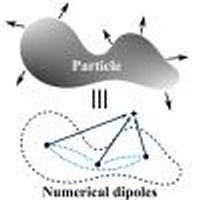当前位置:
X-MOL 学术
›
J. Opt. Soc. Am. A
›
论文详情
Our official English website, www.x-mol.net, welcomes your
feedback! (Note: you will need to create a separate account there.)
Global polarizability matrix method for efficient modeling of light scattering by dense ensembles of non-spherical particles in stratified media.
Journal of the Optical Society of America A ( IF 1.4 ) Pub Date : 2020-01-01 , DOI: 10.1364/josaa.37.000070 Maxime Bertrand , Alexis Devilez , Jean-Paul Hugonin , Philippe Lalanne , Kevin Vynck
Journal of the Optical Society of America A ( IF 1.4 ) Pub Date : 2020-01-01 , DOI: 10.1364/josaa.37.000070 Maxime Bertrand , Alexis Devilez , Jean-Paul Hugonin , Philippe Lalanne , Kevin Vynck

|
We introduce a numerical method that enables efficient modeling of light scattering by large, disordered ensembles of non-spherical particles incorporated in stratified media, including when the particles are in close vicinity to each other, to planar interfaces, and/or to localized light sources. The method consists of finding a small set of fictitious polarizable elements-or numerical dipoles-that quantitatively reproduces the field scattered by an individual particle for any excitation and at an arbitrary distance from the particle surface. The set of numerical dipoles is described by a global polarizability matrix that is determined numerically by solving an inverse problem relying on fullwave simulations. The latter are classical and may be performed with any Maxwell's equations solver. Spatial non-locality is an important feature of the numerical dipoles set, providing additional degrees of freedom compared to classical coupled dipoles to reconstruct complex scattered fields. Once the polarizability matrix describing scattering by an individual particle is determined, the multiple scattering problem by ensembles of such particles in stratified media can be solved using a Green tensor formalism and only a few numerical dipoles, thereby with a low physical memory usage, even for dense systems in close vicinity to interfaces. The performance of the method is studied with the example of large high-aspect-ratio high-index dielectric cylinders. The method is easy to implement and may offer new possibilities for the study of complex nanostructured surfaces, which are becoming widespread in emerging photonic technologies.
中文翻译:

全局极化率矩阵方法,用于通过分层介质中非球形粒子的密集集合对光散射进行有效建模。
我们引入了一种数值方法,该方法可以通过分层介质中掺入的非球形大颗粒无序大团块(包括当颗粒彼此靠近时,平面界面和/或局部光源时)进行有效的光散射建模。 。该方法包括找到一小组虚拟的可极化元素(或数字偶极子),这些元素可定量地再现单个粒子在任何激发条件下以及与粒子表面的任意距离处所散射的场。一组数字偶极子由一个全局极化率矩阵来描述,该矩阵通过依靠全波仿真来解决反问题而在数值上确定。后者是经典的,可以使用任何麦克斯韦方程组求解器执行。空间非局部性是数字偶极子集的重要特征,与经典耦合偶极子相比,它提供了额外的自由度来重建复杂的散射场。一旦确定了描述单个粒子散射的极化率矩阵,就可以使用Green张量形式和仅几个数值偶极子来解决分层介质中此类粒子的聚集所引起的多重散射问题,从而即使对于接口附近的密集系统。以大型高纵横比高折射率介电圆柱为例研究了该方法的性能。该方法易于实施,并可能为研究复杂的纳米结构表面提供新的可能性,这种表面在新兴的光子技术中已变得越来越普遍。
更新日期:2019-12-25
中文翻译:

全局极化率矩阵方法,用于通过分层介质中非球形粒子的密集集合对光散射进行有效建模。
我们引入了一种数值方法,该方法可以通过分层介质中掺入的非球形大颗粒无序大团块(包括当颗粒彼此靠近时,平面界面和/或局部光源时)进行有效的光散射建模。 。该方法包括找到一小组虚拟的可极化元素(或数字偶极子),这些元素可定量地再现单个粒子在任何激发条件下以及与粒子表面的任意距离处所散射的场。一组数字偶极子由一个全局极化率矩阵来描述,该矩阵通过依靠全波仿真来解决反问题而在数值上确定。后者是经典的,可以使用任何麦克斯韦方程组求解器执行。空间非局部性是数字偶极子集的重要特征,与经典耦合偶极子相比,它提供了额外的自由度来重建复杂的散射场。一旦确定了描述单个粒子散射的极化率矩阵,就可以使用Green张量形式和仅几个数值偶极子来解决分层介质中此类粒子的聚集所引起的多重散射问题,从而即使对于接口附近的密集系统。以大型高纵横比高折射率介电圆柱为例研究了该方法的性能。该方法易于实施,并可能为研究复杂的纳米结构表面提供新的可能性,这种表面在新兴的光子技术中已变得越来越普遍。











































 京公网安备 11010802027423号
京公网安备 11010802027423号